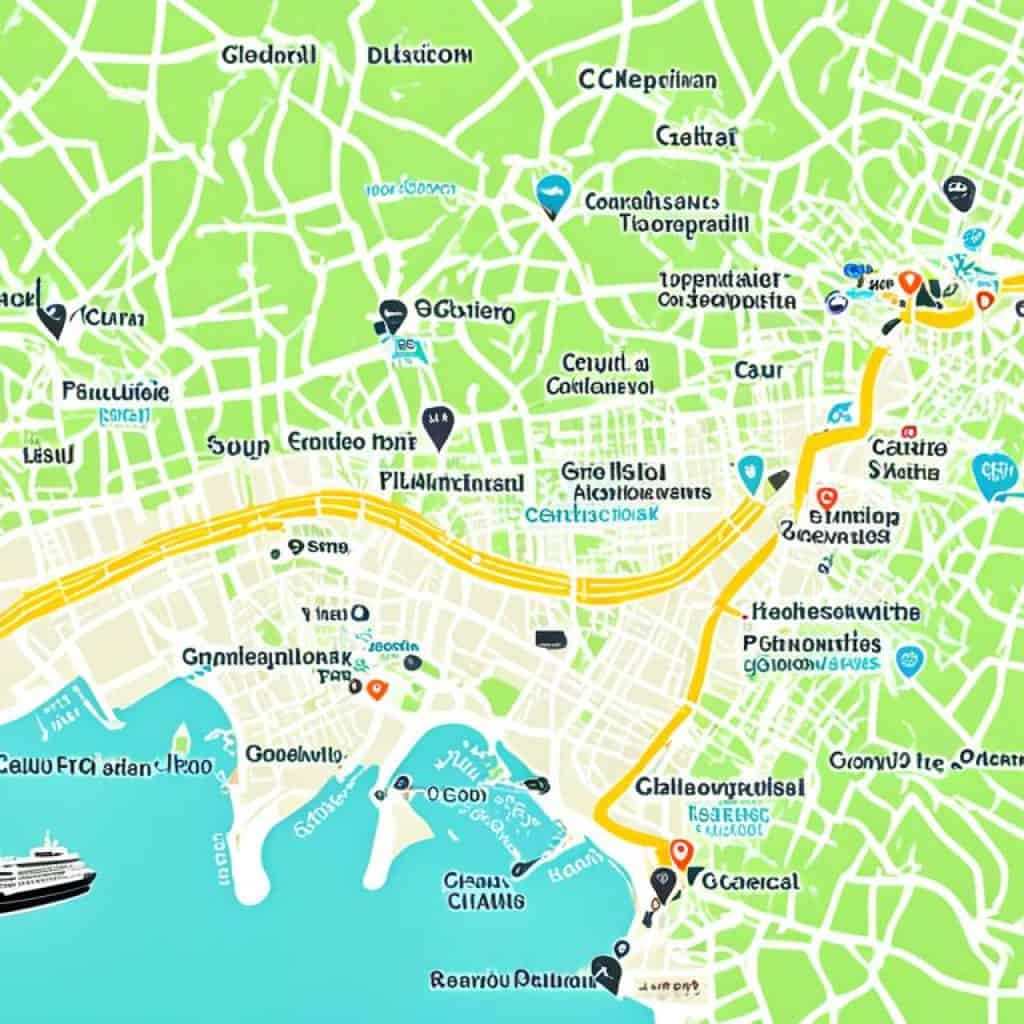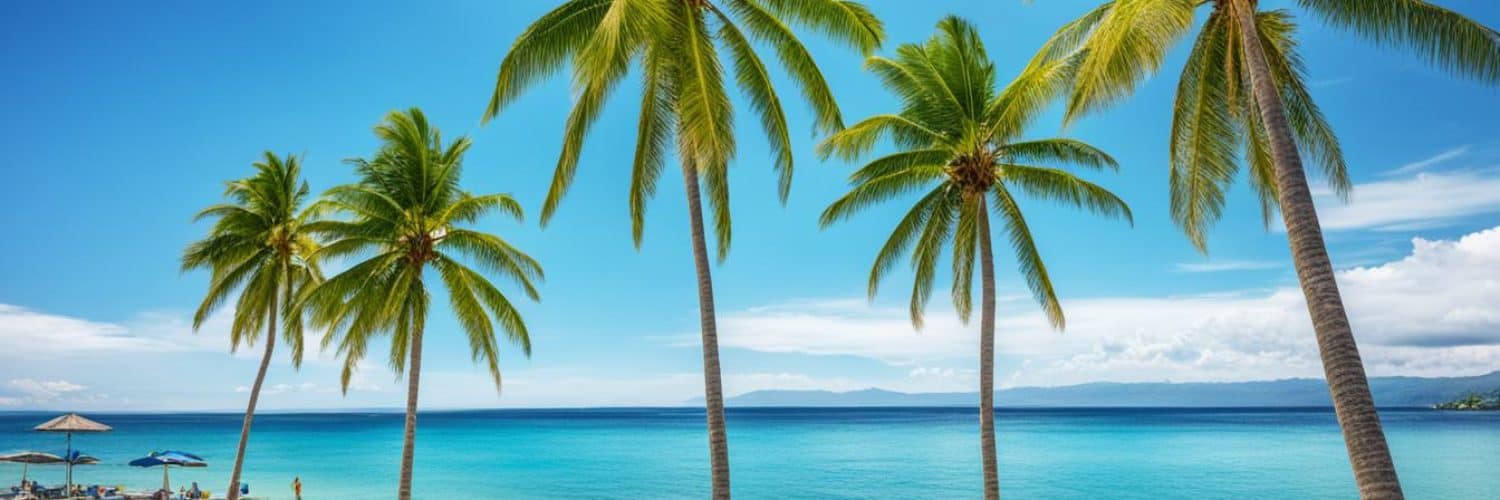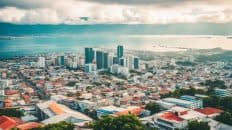Welcome to Cebu, also known as Sugbo, a historical gem nestled in the beautiful Visayas region of the Philippines. This vibrant and culturally rich destination offers a multitude of experiences, from exploring historical landmarks to indulging in mouthwatering local delicacies. Whether you’re a history enthusiast, adventure seeker, or someone who simply wants to relax on pristine beaches, Cebu is the perfect destination for you.
But have you ever wondered what makes Cebu truly special? What secrets does this historical gem hold? What are the hidden treasures waiting to be discovered? Prepare to embark on an unforgettable journey as we unveil the wonders of Sugbo and provide you with the ultimate travel guide to make your trip truly memorable.
Best Time to Go to Cebu
Planning a trip to Cebu? It’s crucial to choose the best time to visit in order to make the most of your experience. The ideal time to explore this beautiful province is during the dry and summer season, which spans from December to May.
During this period, you can expect favorable weather conditions, making it perfect for a wide range of outdoor activities. Whether you want to take a dip in the crystal-clear waters, go diving to discover vibrant marine life, or explore the stunning landscapes, the dry season offers the best conditions for all these adventures.
January holds a special place in the hearts of locals and tourists alike as it’s the month of the renowned Sinulog Festival. This vibrant festival is a celebration of Cebuano culture, filled with colorful parades, street parties, and traditional dances. It’s an event you don’t want to miss, as it showcases the rich heritage of Cebu in all its glory.
For those who prefer smaller crowds and more affordable deals, the months of July to October are considered the low season in Cebu. While you may encounter occasional rain showers during these months, it should not deter you from exploring the beauty that Cebu has to offer. Just make sure to pack an umbrella or raincoat and be prepared for unexpected weather changes.
Climate in Cebu
Cebu has a tropical climate with temperatures ranging from 24°C to 32°C throughout the year. The dry season is characterized by warm temperatures, making it the perfect time for outdoor activities. The cool season, which falls between December and February, offers slightly lower temperatures, providing a pleasant respite from the heat.
It’s always a good idea to check the weather forecast before your trip to Cebu to ensure you are prepared for the conditions during your stay.
| Month | Average Temperature (°C) | Average Rainfall (mm) |
|---|---|---|
| December | 26-31 | 79 |
| January | 25-30 | 59 |
| February | 25-30 | 48 |
| March | 25-31 | 48 |
| April | 26-32 | 61 |
| May | 27-32 | 124 |
Plan your trip accordingly
Traveling during the dry season and experiencing the festivities of the Sinulog Festival will allow you to make the most of your trip to Cebu. However, if you’re looking for a more relaxed and budget-friendly experience, the low season can offer great opportunities. Just be prepared for the occasional rain shower and unpredictable weather.
Whichever time you choose to visit, Cebu’s stunning landscapes, cultural heritage, and warm hospitality will ensure an unforgettable journey. So pack your bags, find your adventure, and get ready to create memories that will last a lifetime.
Climate and Weather in Cebu
When planning your trip to Cebu, it’s important to consider the climate and weather conditions to ensure an enjoyable experience. Cebu enjoys a tropical climate, characterized by warm temperatures and occasional rainfall.
The average temperatures in Cebu range from 24°C to 32°C throughout the year, creating a pleasant and balmy atmosphere ideal for outdoor activities and exploration.
The dry season in Cebu lasts from December to May, offering the best weather conditions for travelers. During this time, you can expect warm temperatures and lower chances of rainfall, making it ideal for beach visits, island-hopping adventures, and exploring the city.
The cool season in Cebu falls between December and February, providing a slight respite from the heat. While temperatures may be slightly lower during this period, they remain comfortable and still allow for outdoor activities.
However, it’s important to note that Cebu can experience occasional rainfall even during the dry season. It’s always advisable to check the weather forecast before your trip to Cebu to ensure favorable conditions for your planned activities.
“The climate in Cebu is perfect for all kinds of outdoor activities, whether you’re lounging on the beach or exploring the city’s historical landmarks. Just remember to check the weather forecast and pack accordingly!”
Monthly Weather Averages in Cebu
| Month | Average Temperature (°C) | Average Rainfall (mm) |
|---|---|---|
| January | 28 | 36 |
| February | 28 | 28 |
| March | 29 | 35 |
| April | 29 | 33 |
| May | 30 | 100 |
| June | 30 | 185 |
| July | 30 | 161 |
| August | 30 | 161 |
| September | 30 | 191 |
| October | 30 | 185 |
| November | 29 | 126 |
| December | 28 | 83 |
As you can see from the monthly weather averages, Cebu experiences slightly higher rainfall from May to October, which is considered the wetter season. However, this doesn’t mean you should avoid visiting during these months. Rain showers in Cebu are usually brief and followed by sunny spells, allowing you to continue your outdoor activities.
Overall, Cebu’s climate and weather conditions make it a fantastic destination year-round. Whether you’re basking in the sun on pristine beaches or exploring the historical landmarks of Cebu City, you’re sure to enjoy the tropical paradise that Cebu has to offer.
How to Get to Cebu
Getting to Cebu is a breeze, whether you’re traveling domestically or internationally. The Mactan-Cebu International Airport serves as the main gateway to the province, offering direct flights from various domestic destinations, including major cities in Luzon and Mindanao. Airlines such as Philippine Airlines, Cebu Pacific, and Air Asia operate frequent flights to Cebu, making it easily accessible for travelers.
If you prefer a scenic sea journey, there are also ferry options available from nearby islands. Cruising to Cebu by ferry allows you to enjoy breathtaking views of the crystal-clear waters and surrounding islands. Whether you choose to travel by air or sea, it’s important to book your transportation in advance to secure the best deals and availability.
Flights to Cebu
When it comes to flights, there are several airlines that offer convenient options for reaching Cebu. Philippine Airlines, the country’s flag carrier, operates numerous daily flights to and from major cities in the Philippines, including Manila, Davao, and Cagayan de Oro. Cebu Pacific, a popular low-cost carrier, also provides affordable and frequent flights to Cebu from various domestic destinations. Air Asia, another budget-friendly airline, offers additional flight options for travelers looking to visit Cebu.
With the availability of multiple airlines and flight schedules, finding a suitable flight to Cebu is relatively easy. It’s advisable to check different airlines and compare prices to secure the best fares for your travel dates.
Ferry to Cebu
If you’re looking for an alternative way to reach Cebu, traveling by ferry is an excellent choice. The Philippines is an archipelago with numerous islands, and ferry travel is a popular mode of transportation among locals and tourists alike.
To reach Cebu by ferry, you can take advantage of the inter-island connections from nearby destinations. For example, you can catch a ferry from Bohol, Negros Oriental, or Leyte to Cebu. These ferry rides often offer scenic views of the ocean and surrounding islands, making for a memorable journey.
It’s important to note that ferry schedules may vary, so it’s recommended to check the timings in advance and plan your trip accordingly. Booking your tickets early is also advisable, especially during peak travel seasons or holidays.
Where to Stay in Cebu
Cebu, with its vibrant culture and stunning attractions, offers a wide range of accommodations to suit every traveler’s needs. Whether you’re on a budget or looking for a luxurious escape, there are plenty of options to choose from. Here’s a breakdown of the different types of accommodations available in Cebu:
Budget Accommodations
For budget-conscious travelers, Cebu offers a variety of affordable guesthouses, hostels, and budget hotels. These accommodations provide basic amenities and a comfortable stay without breaking the bank. You can find budget options in Cebu City and other popular areas, offering convenient access to attractions and public transportation.
Mid-range Accommodations
If you’re looking for more comfort and amenities without sacrificing your budget, mid-range hotels and resorts are a great option. These accommodations offer cozy rooms, additional facilities such as swimming pools and fitness centers, and quality services. You can choose from a range of mid-range options in different areas of Cebu, ensuring a convenient and enjoyable stay.
Luxury Accommodations
For those seeking the ultimate luxury experience in Cebu, the province boasts high-end resorts and boutique hotels that cater to discerning travelers. These accommodations provide top-notch facilities, luxurious rooms, exquisite dining options, and personalized service. Pamper yourself in style and indulge in the finest amenities that Cebu has to offer.
It is advisable to book your accommodation in advance, especially during peak seasons, to secure the best deals and availability. Whether you’re a budget traveler, looking for a mid-range stay, or seeking a luxurious escape, Cebu has the perfect accommodation to suit your preferences and make your stay memorable.
Accommodation Options in Cebu
| Accommodation Type | Description |
|---|---|
| Budget Accommodations | Affordable guesthouses, hostels, and budget hotels with basic amenities. |
| Mid-range Accommodations | Comfortable hotels and resorts with additional facilities and services. |
| Luxury Accommodations | High-end resorts and boutique hotels offering top-notch facilities and personalized service. |
For a visual representation of the different types of accommodations available in Cebu, refer to the table above. Use this information to choose the perfect accommodation for your stay in Cebu and make your trip truly unforgettable.
What to See and Do in Cebu City
Cebu City, the capital of Cebu, is a treasure trove of historical and cultural attractions. As you explore this vibrant city, there are several must-see landmarks that should be on your itinerary.
Fort San Pedro
One of the oldest and most significant historical sites in Cebu City is Fort San Pedro. This centuries-old military fortification is a testament to the city’s rich history. Take a walk through the fort’s well-preserved walls and learn about its role in Spanish colonization and defense against pirate attacks.
Basilica del Santo Niño
Immerse yourself in Cebu’s religious heritage by visiting the Basilica del Santo Niño. This iconic church is not only a place of worship but also a historical landmark. It houses the Santo Niño de Cebu, a statue of the Child Jesus that dates back to the arrival of Ferdinand Magellan in 1521. Witness the devotion of the locals and experience the vibrant atmosphere during mass.
Magellan’s Cross
A visit to Cebu City would not be complete without seeing Magellan’s Cross. This historical landmark symbolizes the introduction of Christianity to the Philippines. The cross is believed to be planted by Ferdinand Magellan himself upon his arrival in Cebu. Take a moment to admire this significant piece of history and reflect on its impact on the Filipino culture.
Aside from these landmarks, Cebu City offers much more to see and do. Explore the city’s rich history by strolling through its colonial-era streets and visiting museums that showcase Cebu’s cultural heritage. Don’t forget to indulge in the local delicacies, such as Cebu’s famous lechon, and immerse yourself in the vibrant street markets to experience the authentic flavors and vibrant atmosphere of the city.
Cebu City is a destination that seamlessly blends history, culture, and culinary delights. Whether you’re a history enthusiast, a food lover, or a curious traveler, Cebu City has something to offer everyone. Discover the city’s hidden gems, immerse yourself in its rich heritage, and create lasting memories in this captivating destination.
Plan your trip to Cebu City with this guide and make sure to visit these iconic landmarks for a truly unforgettable experience.
What to See and Do in North Cebu
North Cebu is a treasure trove of incredible natural wonders and exciting outdoor adventures. This region offers a diverse range of destinations that will captivate the hearts of travelers.
Thresher Sharks in Malapascua

Diving enthusiasts will be thrilled to witness the majestic thresher sharks in Malapascua. This world-renowned dive spot provides a unique opportunity to encounter these mesmerizing creatures in their natural habitat. Dive deep into the depths of the ocean and marvel at the awe-inspiring beauty of these magnificent sharks.
White Sand Beaches of Bantayan Island
Bantayan Island is a paradise for beach lovers, boasting pristine white sand beaches that sparkle under the tropical sun. Unwind, relax, and soak up the beauty of the turquoise waters as you bask in the tranquility of this island sanctuary. Enjoy various beach activities like swimming, sunbathing, or simply strolling along the shorelines.
Camotes Island: A Hidden Gem
Camotes Island is a hidden gem waiting to be discovered. Adventure-seekers can explore the island’s caves through spelunking, dive into crystal-clear waters with cliff diving, or paddle through captivating lagoons with kayaking. Embrace the raw beauty of this untouched paradise, where nature’s wonders will leave you in awe.
| Destination | Main Attraction |
|---|---|
| Malapascua | Thresher Sharks |
| Bantayan Island | White Sand Beaches |
| Camotes Island | Spelunking, Cliff Diving, Kayaking |
Venture into North Cebu and let these incredible destinations take you on an unforgettable journey. From the mesmerizing thresher sharks in Malapascua to the pristine white sand beaches of Bantayan Island and the hidden wonders of Camotes Island, North Cebu promises remarkable experiences and lasting memories.
What to See and Do in South Cebu
South Cebu is a treasure trove of natural wonders and cultural landmarks that will captivate adventurous travelers. Explore the diverse offerings of this region, from stunning religious sites to exhilarating water activities and breathtaking scenic landscapes.
1. Simala Shrine
The Simala Shrine is a prominent pilgrimage site in South Cebu known for its exquisite architecture and religious significance. Located in Sibonga, this stunning shrine is dedicated to the Virgin Mary and features intricate designs and beautiful gardens. Visitors can marvel at the impressive facade, light candles, and offer prayers in this serene and awe-inspiring sanctuary.
2. Moalboal Sardine Run
Experience the mesmerizing Moalboal Sardine Run and swim alongside millions of sardines in the crystal-clear waters of Moalboal. This natural phenomenon attracts divers and snorkelers from around the world who are eager to witness the spectacle of these shimmering fish forming massive schools. Immerse yourself in this underwater spectacle and be amazed by the harmony and beauty of nature.
3. Kawasan Falls
Located in Badian, Kawasan Falls is a stunning three-tiered waterfall that offers a refreshing and picturesque escape from the heat. The turquoise blue waters and lush greenery create a tranquil oasis where visitors can swim, relax, and soak up the natural beauty. For the more adventurous, canyoneering tours are available, allowing you to jump, swim, and trek your way through the canyons and experience an adrenaline-pumping adventure.
4. Osmeña Peak
Journey to Osmeña Peak, the highest peak in Cebu, and feast your eyes on breathtaking panoramic views of the surrounding landscape. Located in Dalaguete, this stunning mountain range offers a relatively easy hike that rewards climbers with an unforgettable sunrise or sunset experience. Marvel at the undulating hills, green pasturelands, and distant sea views, creating a dramatic and memorable vista.
With its blend of cultural landmarks and natural wonders, South Cebu promises an unforgettable travel experience. From the intricate architecture of the Simala Shrine to the captivating spectacle of the Moalboal Sardine Run, the region offers a diverse range of attractions for every adventurer. Don’t miss the chance to visit the majestic Kawasan Falls and witness the breathtaking views from Osmeña Peak. South Cebu is a destination that will leave you in awe of its beauty and cultural richness.
| Attraction | Description |
|---|---|
| Simala Shrine | A famous pilgrimage site known for its stunning architecture and religious significance. |
| Moalboal Sardine Run | An exhilarating experience where you can swim with millions of sardines in crystal-clear waters. |
| Kawasan Falls | A breathtaking three-tiered waterfall offering a serene oasis for swimming and canyoneering adventures. |
| Osmeña Peak | The highest peak in Cebu, providing panoramic views of the surrounding landscape and an unforgettable sunrise or sunset experience. |
What to Eat and Drink in Cebu
Cebu is a paradise for food lovers, offering a wide variety of delectable dishes and local delicacies. When exploring this vibrant city, make sure to indulge in the unique flavors and culinary delights that Cebu has to offer. From world-famous Cebuano lechon to savory street food, here are some must-try dishes and beverages that will satisfy your cravings:
Cebuano Lechon
One of the highlights of Cebu’s food scene is Cebuano lechon, a mouthwatering roasted pig dish. The succulent meat and perfectly crispy skin are what make this dish truly extraordinary. Whether you’re visiting restaurants or local street stalls, you’ll find Cebuano lechon being prepared and served with utmost care and expertise. Sink your teeth into this flavorful delicacy and experience a gastronomic delight like no other.
Puso (Hanging Rice)
Puso, or hanging rice, is a unique way of cooking rice in Cebu. It is rice grains cooked inside triangular pouches made from woven coconut leaves. This portable and convenient way of serving rice is perfect for enjoying with grilled dishes, such as barbecued chicken or pork. The aromatic fragrance of the coconut leaves enhances the flavor of the rice, creating a delightful combination that will leave you craving for more.
Siomai from Tisa
Tisa is a neighborhood in Cebu City renowned for its mouthwatering siomai. Siomai is a type of Chinese dumpling, and Tisa’s version is particularly famous for its flavorful filling and homemade chili sauce. These bite-sized dumplings are best enjoyed with a squeeze of calamansi (Filipino lime) and dipped in the spicy sauce for an explosion of flavors.
Savory Churros
Cebu’s version of churros adds a savory twist to the classic Spanish treat. Instead of the traditional sweet and cinnamon-coated churros, Cebu’s churros are dusted with cheese powder and served with a rich chocolate or cheese dip. This unique combination of sweet and savory flavors will surely satisfy your taste buds and leave you craving for more.
Fresh Seafood and Tropical Fruits
Being an island province, Cebu is abundant in fresh seafood. From succulent grilled squid to mouthwatering shrimp dishes, you’ll find a wide variety of seafood options to tantalize your taste buds. Don’t forget to complement your meal with tropical fruits like mangoes, pineapples, and bananas, which are widely available throughout the province. The natural sweetness and juiciness of these fruits are the perfect refreshing treat in Cebu’s tropical climate.
Refreshing Beverages
To quench your thirst, make sure to try the refreshing beverages available in Cebu. Freshly squeezed fruit juices, such as calamansi or mango, are a popular choice. Don’t miss the opportunity to try buko juice, a refreshing coconut water straight from the coconut itself. For a truly local experience, try halo-halo, a colorful and layered dessert drink made with crushed ice, sweet beans, jellies, and topped with evaporated milk and leche flan.
When visiting Cebu, exploring its culinary scene is a must. From the world-famous Cebuano lechon to the exotic flavors of street food, your taste buds will be treated to a delightful culinary adventure in this gastronomic destination.
Practical Information and Tips for Traveling in Cebu
When planning your trip to Cebu, it’s important to be equipped with practical information that will help ensure a smooth and enjoyable experience. Here are some essential tips to keep in mind:
Currency
The official currency in Cebu is the Philippine Peso (PHP). It is recommended to have local currency on hand for convenience, especially when visiting local markets, street vendors, or smaller establishments that may not accept credit cards.
Language
English and Filipino are widely spoken in Cebu, making communication easier for English-speaking travelers. You’ll find that most locals, especially those in the tourism industry, can understand and speak English fluently. Basic Filipino phrases can also come in handy and are appreciated by the locals.
Local Customs and Etiquette
Respecting local customs and etiquette is important when traveling in Cebu. Here are a few tips to keep in mind:
- When entering places of worship, such as churches or temples, dress modestly and remove your footwear if required.
- When interacting with locals, a friendly smile and polite greeting go a long way.
- Be mindful of conservative cultural norms, particularly in rural areas.
- If invited to someone’s home, it is customary to bring a small gift for the host.
- Public displays of affection should be kept to a minimum.
- Always ask for permission before taking photos of people, especially those engaged in religious or cultural activities.
- Tipping is not mandatory but is appreciated for good service.
Travel Tips
In addition to the practical information mentioned above, here are some general travel tips for your trip to Cebu:
- Stay hydrated by drinking plenty of water, especially during the hot and humid months.
- Apply sunscreen regularly, as the tropical sun can be intense.
- Keep important documents, such as your passport and travel insurance, in a safe place.
- Be cautious with your personal belongings in crowded areas and tourist spots.
- Use reliable transportation options, such as trusted taxi companies or ride-sharing services.
- Research and follow local safety guidelines and precautions.
- If you have any medical conditions or require specific medication, ensure you have an ample supply and carry any necessary documentation.
By being prepared with practical information and following these tips, you’ll have a memorable and hassle-free journey in Cebu.

Sample Itinerary for Exploring Cebu
To make the most of your time in Cebu, a well-planned itinerary is essential. Here’s a sample itinerary that includes activities to explore the best of what Cebu has to offer:
- Day 1: Mactan Island-Hopping and Cebu City Sightseeing
- Day 2: Camotes Islands and Kawasan Falls
- Day 3: Simala Shrine and Moalboal Sardine Run
Start your day by embarking on an exciting Mactan Island-Hopping adventure. Explore the stunning islands surrounding Mactan, snorkel in crystal-clear waters, and relax on pristine beaches. Afterward, head to Cebu City for sightseeing. Visit historical landmarks such as the iconic Fort San Pedro, the oldest military fort in the Philippines. Pay your respects at the Basilica del Santo Niño, home to the revered Santo Niño de Cebu. Don’t forget to stop by Magellan’s Cross, a historical site marking the arrival of Ferdinand Magellan in Cebu.
Spend the second day exploring the beautiful Camotes Islands. Immerse yourself in the island’s natural beauty, unwind on pristine beaches, and take in breathtaking views. You can also indulge in thrilling activities such as cliff jumping and kayaking. In the afternoon, visit the picturesque Kawasan Falls in Badian. Take a refreshing dip in the turquoise blue waters or go canyoneering for an exhilarating adventure.
On the third day, journey to Sibonga to visit the magnificent Simala Shrine. Marvel at the grandeur of the shrine’s architecture and explore its spiritual beauty. Afterward, head to Moalboal to experience the famous Sardine Run. Strap on your snorkeling gear and swim alongside millions of sardines gracefully moving in synchronized formations. It’s a sight you won’t want to miss!
This sample itinerary provides a balanced mix of beach relaxation, cultural exploration, and outdoor adventures, allowing you to make the most of your time in Cebu. Feel free to customize it based on your preferences and the duration of your stay. Enjoy your unforgettable journey through Cebu’s wonders!
Discover the Unique Attractions in Cebu
Cebu, also known as the Queen City of the South, is renowned for its unique attractions that cater to every traveler’s interests. Whether you’re an adventure seeker, a history enthusiast, or a food lover, Cebu has something special in store for you. From its breathtaking islands and beaches to its fascinating historical landmarks and mouthwatering local delicacies, Cebu offers a diverse range of experiences that will leave you in awe.
Islands and Beaches
One of the main draws of Cebu is its picturesque islands and stunning beaches. The province is home to world-famous destinations such as Malapascua, which is known for its incredible diving spots and the chance to spot thresher sharks. Bantayan Island boasts powdery white sand beaches and crystal clear waters, perfect for swimming and sunbathing. Camotes Island offers a tranquil escape with its pristine beaches and untouched natural beauty. From snorkeling and diving to island hopping and beach bumming, Cebu’s islands and beaches will enchant any beach lover.
Historical Landmarks
Cebu is steeped in history and is home to several historical landmarks that tell the story of its rich past. Visit Fort San Pedro, the oldest triangular fortress in the Philippines, and immerse yourself in its historical significance. The Basilica del Santo Niño, a symbol of Cebu’s deep Catholic faith, houses the revered Santo Niño de Cebu. Another significant landmark is Magellan’s Cross, which marks the spot where Ferdinand Magellan first introduced Christianity to the Philippines. Exploring these landmarks allows you to delve into Cebu’s fascinating history.
Local Delicacies
A trip to Cebu wouldn’t be complete without indulging in its delectable local delicacies. Cebuano lechon, a mouthwatering roasted pig dish, is a must-try specialty that locals and tourists alike rave about. The crispy skin and succulent meat make it a true culinary delight. Another popular dish is puso, or hanging rice, which is wrapped in coconut leaves and goes perfectly with grilled meats. Don’t forget to try the famous siomai from Tisa for a flavorful and satisfying snack. Exploring Cebu’s food scene will take your taste buds on a delightful journey.
Enjoy the Vibrant Culture of Cebu: Things to Do and Places to Visit
Immerse yourself in the vibrant culture of Cebu by engaging in various activities and visiting notable places. This beautiful province in the Philippines offers a diverse range of experiences that highlight its unique heritage and character. From attending vibrant festivals to exploring the local arts and crafts scene, Cebu has something for everyone.
One of the highlights of Cebu’s cultural calendar is the Sinulog Festival, held annually in January. This grand celebration showcases traditional dances and performances, filling the streets with energy and excitement. It is a colorful feast for the senses that shouldn’t be missed.
When exploring Cebu, take the time to witness the rich history and tradition. Visit historical landmarks like Fort San Pedro, a centuries-old military fortification that offers a glimpse into the province’s past. Explore the iconic Basilica del Santo Niño, one of the oldest churches in Asia, and pay respects to Magellan’s Cross, a significant historical site marking the arrival of Ferdinand Magellan.
For those who appreciate art and craftsmanship, Cebu has a thriving arts scene. Discover local artisans and their creations by visiting art galleries and craft markets. You’ll find beautifully handcrafted items such as intricate woodcarvings, woven textiles, and delicately made jewelry.
No visit to Cebu would be complete without sampling the local cuisine. Venture into local markets and street food stalls to savor the flavors of Cebu. Indulge in Cebuano lechon, the succulent roasted pig dish that the province is famous for. Don’t miss out on trying other local delicacies such as puso (hanging rice) and siomai from Tisa.
The vibrant culture of Cebu is showcased in its festivals, historical landmarks, and culinary traditions. Immerse yourself in the local arts and crafts scene, witness the grandeur of the Sinulog Festival, and indulge in delicious Cebuano dishes. Cebu offers a unique cultural experience that will leave you with lasting memories.
Places to Visit in Cebu
When exploring Cebu, there are several places that are worth a visit. The table below highlights some of the top attractions:
| Place | Description |
|---|---|
| Mactan Island | Known for its beautiful beaches and historical sites |
| Bantayan Island | Home to pristine white sand beaches and crystal-clear waters |
| Moalboal | A popular spot for diving and snorkeling, known for its sardine run |
| Simala Shrine | A famous pilgrimage site with stunning architecture |
| Kawasan Falls | A three-tiered waterfall perfect for canyoneering and swimming |
These are just a few of the many incredible places you can explore in Cebu. Whether you’re seeking natural beauty, historical landmarks, or cultural experiences, Cebu has it all.
Immerse yourself in the vibrant culture of Cebu, where traditions and history come to life. From attending festivals to exploring historical landmarks and savoring local delicacies, every moment in Cebu is an opportunity to embrace the rich heritage of this beautiful province.
Explore Cebu’s Natural Wonders: From Beaches to Waterfalls
Cebu, known for its historical landmarks and vibrant culture, also boasts an array of natural wonders that will take your breath away. From picturesque beaches with crystal-clear waters to enchanting waterfalls hidden amidst lush forests, Cebu’s natural beauty is truly captivating. Whether you’re seeking relaxation or adventure, there are plenty of scenic spots to explore. Let’s dive into some of the best beaches and waterfalls that Cebu has to offer.
Beaches in Cebu
When it comes to beaches, Cebu doesn’t disappoint. One of the must-visit destinations is Bantayan Island, known for its pristine white sand beaches and turquoise waters. Spend a day lounging on the soft sands, swimming in the refreshing ocean, or simply basking in the sun’s warm embrace. It’s the perfect escape for beach lovers looking to unwind and rejuvenate.
Other beach destinations in Cebu include Malapascua Island and Moalboal. Malapascua Island is renowned for its stunning underwater landscape and the opportunity to swim with thresher sharks, while Moalboal offers pristine beaches and incredible marine biodiversity. Snorkeling and diving enthusiasts will find themselves in paradise as they explore the vibrant coral reefs and encounter an abundance of marine life.
Waterfalls in Cebu
Cebu is also home to magnificent waterfalls that are sure to leave you in awe. One of the most popular waterfalls is Kawasan Falls, located in Badian. Surrounded by lush greenery, Kawasan Falls features cascading turquoise waters and is a popular spot for canyoneering. Embark on an adrenaline-pumping adventure as you jump into natural pools, trek through the canyons, and marvel at the breathtaking beauty of the falls.
“Kawasan Falls is a true gem of nature. The combination of its crystal-clear waters and breathtaking surroundings creates a magical experience that you won’t forget.” – Traveler’s Review
Another waterfall worth visiting is Tumalog Falls, situated in Oslob. Known for its ethereal beauty, Tumalog Falls resembles a curtain of delicate water veiling a cave. Its enchanting atmosphere will transport you to a world of tranquility and natural splendor.
| Waterfall | Location | Description |
|---|---|---|
| Kawasan Falls | Badian | A three-tiered waterfall offering beautiful natural pools and canyoneering opportunities. |
| Tumalog Falls | Oslob | An enchanting waterfall with a curtain-like appearance, creating a magical atmosphere. |
| Inambakan Falls | Ginatilan | A towering waterfall nestled amidst lush greenery, perfect for nature lovers and adventurers. |
Exploring these natural wonders in Cebu is an opportunity to connect with Mother Nature and experience the beauty of the Philippines’ landscapes. Whether you’re relaxing on the pristine beaches or immersing yourself in the tranquility of waterfalls, Cebu’s natural wonders will leave you with unforgettable memories.
Conclusion
Embarking on a journey to Sugbo, also known as Cebu, is a captivating experience that allows you to immerse yourself in a rich cultural heritage and explore stunning destinations. From the historical landmarks of Cebu City to the natural wonders of North and South Cebu, there’s something for every traveler to enjoy. Sample delicious local cuisine, witness vibrant festivals, and create unforgettable memories in this historical gem in the Visayas. Plan your trip to Cebu using this ultimate travel guide, and get ready for an adventure of a lifetime.


















Add comment